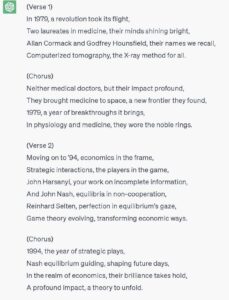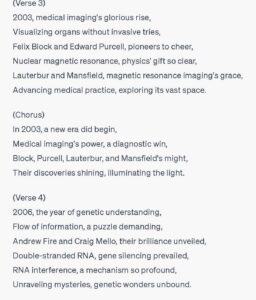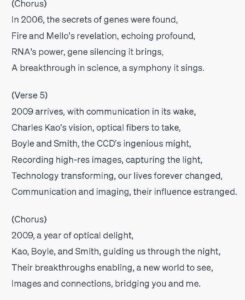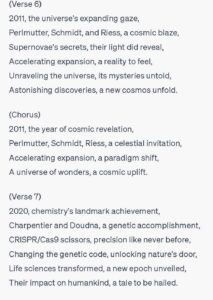I had a delightful lunch last week (at Lucca) with Nico Slate and Arko Dasgupta – see La Femme Nikki? for background – and over the course of discussions on wide-ranging topics, John Coltrane came up, and of course, it instantly reminded me of My Favorite Things (1961).
As I walked back to my office, I received an email from Tinglong Dai, who used ChatGPT to convert my blog post The Physics of Glimpse to a (happy) Taylor Swift song.
So, I could not resist – Look what you made me do, Tinglong!😏 – asking ChatGPT to write a song like My Favorite Things, from:
The Sound of Music is a 1965 American musical drama film produced and directed by Robert Wise, and starring Julie Andrews and Christopher Plummer. The film is an adaptation of the 1959 stage musical, composed by Richard Rodgers, with lyrics by Oscar Hammerstein II. The Sound of Music received five Academy Awards, including Best Picture and Best Director.




What did I “feed” ChatGPT? A few of my favorite Nobels.☺️
- Physiology and Medicine.
Neither of this year’s laureates in physiology or medicine is a medical doctor. Nevertheless, they have achieved a revolution in the field of medicine. It is sometimes said that this new X-ray method that they have developed – computerized tomography – has ushered medicine into the space age.
Allan Cormack and Godfrey Hounsfield! Few laureates in physiology or medicine have, at the time of receiving their prizes, to the degree that you have, satisfied the provision in Alfred Nobel’s will that stipulates that the prizewinner “shall have conferred the greatest benefit on mankind.” Your ingenious new thinking has not only had a tremendous impact on everyday medicine; it has also provided entirely new avenues for medical research.
- Economic Sciences.
Many situations in society, from everyday life to high-level politics, are characterized by what economists call strategic interactions. When there is strategic interaction, the outcome for one agent depends not only on what that agent does, but also very largely on how other agents act or react.
Non-cooperative game theory deals with situations where the parties cannot make binding agreements. Even in very complicated games, with many parties and many available strategies, it will be possible to describe the outcome in terms of a so-called Nash equilibrium – so named after one of the Laureates.
Professor John Harsanyi, the analysis of games with incomplete information is due to you, and it has been of great importance for the economics of information.
Dr John Nash, your analysis of equilibria in non-cooperative games, and all your other contributions to game theory, have had a profound effect on the way economic theory has developed in the last two decades. Professor Reinhard Selten, your notion of perfection in the equilibrium analysis has substantially extended the use of non-cooperative game theory.
Of course, many of us have seen:
A Beautiful Mind is a 2001 American biographical drama film directed by Ron Howard. Written by Akiva Goldsman, its screenplay was inspired by Sylvia Nasar‘s 1998 biography of the mathematician John Nash, a Nobel Laureate in Economics. It went on to gross over $313 million worldwide (on a budget of $58 million) and won four Academy Awards.
- Physiology and Medicine.
To be able to visualize the inner organs of humans without invasive techniques is of paramount importance to modern medicine. Medical imaging has undergone a dramatic development during the last 30 years. A whole series of imaging modalities have been discovered and developed, among which the development of computer assisted tomography was awarded a Nobel Prize in Physiology or Medicine in 1979. Magnetic Resonance Imaging, MRI, represents a new modality for obtaining diagnostic medical images.
Felix Block and Edward Mills Purcell first demonstrated the physical phenomenon of nuclear magnetic resonance in 1946. These discoveries were awarded a Nobel Prize in Physics in 1952.
Professor Lauterbur and Professor Mansfield,
Your discoveries of imaging with magnetic resonance have played a seminal role in the development of one of the most useful imaging modality in medicine today. All indications are that it will be even more important in the future of both medical practice and research, and, above all for the patient.
- Physiology and Medicine.
No information is more important to us than that which governs how we become humans. It instructs our stem cells to differentiate into nerve, blood and muscle cells, tells the organs how to develop and determines how we handle injuries and infections.
Fifteen years ago, we thought we knew enough about the flow of genetic information to use it for practical purposes. But we did not achieve the expected results. Attempts to silence a gene in an experimental animal were sometimes fruitless, and attempts to use gene technology for improving the colours of flowers could even cause the plants to lose colour completely. These results perplexed the scientific community. Was there an unknown regulatory step on the way from DNA to protein?
This enigma was solved by the 2006 Nobel Laureates, Andrew Fire and Craig Mello. In their brilliant paper from 1998, Andrew Fire and Craig Mello demonstrated that double-stranded RNA activates an enzymatic mechanism that leads to gene silencing, with the genetic code in the RNA molecule determining which gene to silence. Today, we call this mechanism RNA interference.
- Physics.
This year’s Nobel Prize in Physics rewards work that has had a decisive impact both on our daily lives and on scientific progress.
It was not until after Charles Kao showed the way in 1966 towards successful transmission using ultra-pure glass fibers that this new communication technology made its breakthrough. Only four years later, the optical fibers that Kao predicted had become possible, and today his vision of a future communication-based society has become a reality.
Video technology and digital photography play a very prominent role in our daily lives, thanks to television and digital cameras. In science and technology, such tools are irreplaceable today.
One technology that has been of crucial importance in making this possible originated from an invention made in 1969 by Willard Boyle and George Smith.
Through its simple structure and ingenious function, the CCD enables very efficient and sensitive recording, storage and read-out of high-resolution images in electronic form. As an image sensor, the CCD usually serves as the electronic eye of advanced digital cameras and TV cameras. It is also a very central component of many scientific and medical devices, for example astronomical telescopes and instruments used for “key-hole” surgery.
Dr Kao, Dr Boyle, Dr Smith:
You have been awarded the 2009 Nobel Prize in Physics for your ground-breaking contributions to optical communication and image recording.
- Physics.
By observing distant galaxies with the help of telescopes, nearly 100 years ago scientists discovered that our universe is getting bigger and bigger. The distances between the galaxies are constantly increasing, like the spaces between raisins in a raisin cake swelling in the oven.
The scientists who are being awarded the Nobel Prize in Physics today have studied distant star explosions – supernovae. To everyone’s utter amazement, the supernovae seemed to be much too dim – weaker than expected if the expansion of the universe had slowed down. Instead, the universe has been expanding faster and faster.
The discovery of accelerating expansion through studies of distant supernovae has thus changed our image of the universe in an unexpected, dramatic way. We have realised that we live in a universe which largely consists of components that are unknown to us. Professor Perlmutter, Professor Schmidt, Professor Riess,
You have been awarded the Nobel Prize in Physics for the discovery of the accelerating expansion of the Universe through observations of distant supernovae.
- Chemistry.
Today we celebrate another scientific breakthrough resulting from an international collaboration, between a French scientist working in the northern part of Sweden and an American scientist based in sunny California.
With the discovery of the CRISPR/Cas9 genetic scissors, Emmanuelle Charpentier and Jennifer A. Doudna have provided us with a tool that can be used to change the genetic information of animals, plants and microorganisms with extremely high precision. Emmanuelle Charpentier and Jennifer A. Doudna. Your studies of the CRISPR/Cas9 genetic scissors have taken the molecular life sciences into a new epoch, and are bringing a great benefit to humankind in many ways.










